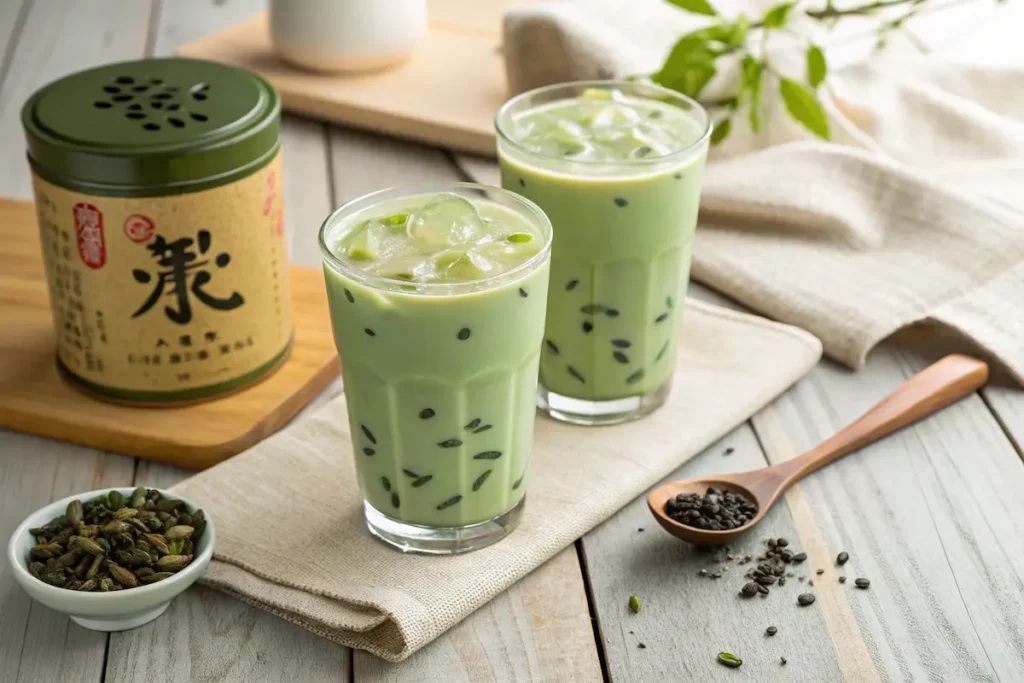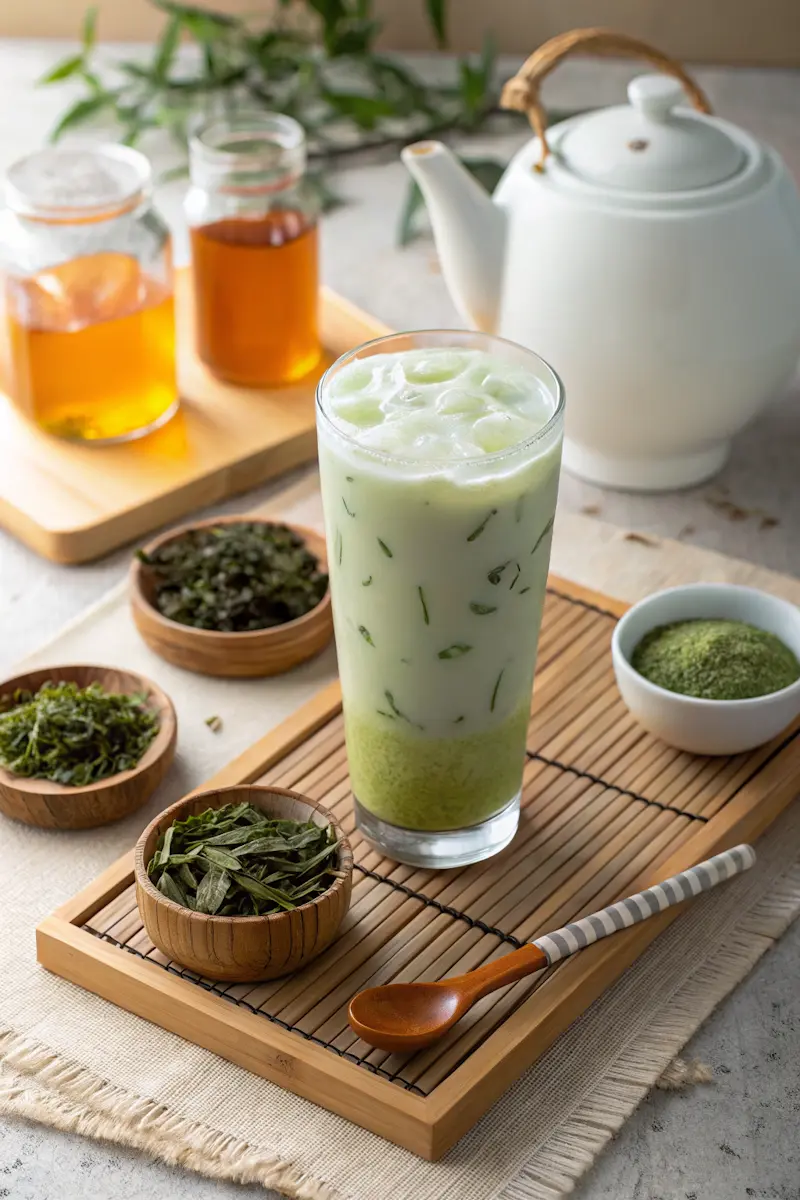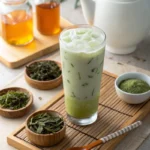Green milk tea is one of the most refreshing, versatile drinks you can make at home. Unlike matcha-based lattes, this guide focuses on green teas like sencha, genmaicha, and gyokuro. Each offers a unique flavor profile that blends beautifully with milk. Whether you prefer grassy, nutty, or umami-rich undertones, learning how to brew your own green milk tea lets you customize sweetness, creaminess, and even texture. In this article, I’ll walk you through types of green tea, steeping methods, ingredients, and techniques so you can confidently create a satisfying cup every time.
Table of Contents
The Story & Intro
What is Green Milk Tea (in general, not just matcha)?
My first sip of green milk tea outside of a matcha latte happened entirely by accident. I was experimenting with leftover genmaicha from a gift set, and I thought, “What if I added oat milk?” The result was warm, nutty, and smooth—completely different from matcha’s sharp edge. That’s when I realized green milk tea is a whole category of deliciousness, not just a matcha trend.
Green milk tea refers to any milk tea made using green tea as the base—excluding matcha. From toasted genmaicha to sweet sencha, the world of green teas opens a door to a customizable drink that’s light, soothing, and easy to make. It’s especially popular in Asia and bubble tea shops worldwide, where variations continue to grow in popularity.
Fresh, smooth, and versatile, green milk tea offers an experience that’s lighter than black milk tea and gentler than the grassy punch of matcha. Whether you want a cozy warm drink or an iced mid-afternoon treat, this recipe shows you how to create your own blend using different types of green tea leaves. The best part? You get full control over sweetness, dairy (or dairy-free) options, and even caffeine levels.
My exploration of this drink led me through dozens of teas, from budget-friendly bancha to luxurious gyokuro. And I’ll share what I’ve learned with you—including how to choose the best tea for your taste and how to steep it without bitterness. Get ready to craft a beverage that’s comforting, refreshing, and uniquely yours.
PrintHomemade Green Milk Tea Recipe: A Refreshing and Customizable Beverage
Green milk tea is a customizable, refreshing drink made from green teas like sencha, genmaicha, or gyokuro blended with milk and sweetener for a light yet flavorful beverage.
- Prep Time: 5 minutes
- Cook Time: 5 minutes
- Total Time: 10 minutes
- Yield: 1 serving 1x
- Category: Beverages
- Method: Steeping
- Cuisine: Asian-Inspired
Ingredients
- 1½ tsp loose-leaf green tea or 1–2 tea bags
- 1 cup (240 ml) filtered water
- 1–2 tsp simple syrup, honey, or brown sugar syrup
- ¼ cup (60 ml) milk (whole, oat, almond, soy, etc.)
- Optional: Ice cubes, vanilla extract, boba, whipped cream, or matcha powder
Instructions
- Select your green tea: sencha, genmaicha, bancha, or gyokuro
- Heat your water to the appropriate temperature (130–185°F based on tea type)
- Steep tea for 1–3 minutes and strain
- Add sweetener while tea is warm and stir
- Add milk and stir well to blend
- Optional: Froth milk or add toppings like boba or whipped cream
- Serve in a mug or glass and enjoy
Notes
Adjust sweetness, milk type, and tea strength to your taste. Avoid oversteeping to prevent bitterness.
Nutrition
- Serving Size: 1 cup
- Calories: 80
- Sugar: 5g
- Sodium: 30mg
- Fat: 3g
- Saturated Fat: 1g
- Unsaturated Fat: 2g
- Trans Fat: 0g
- Carbohydrates: 10g
- Fiber: 0g
- Protein: 2g
- Cholesterol: 5mg

Why Make This Green Milk Tea? (Benefits & Unique Selling Points)
Flavor Variety: Discover the richness of green tea diversity
One of the biggest reasons to make green milk tea at home is flavor freedom. Unlike the often one-dimensional matcha latte, green milk tea lets you explore a range of nuanced tastes. Sencha delivers a light, grassy profile perfect for spring afternoons. Genmaicha adds a toasted, popcorn-like depth that’s cozy and nostalgic. Bancha gives a stronger, more robust tea body, while gyokuro offers a luxurious umami richness that pairs beautifully with creamy milk.
Each tea lends its character to the cup—earthy, vegetal, nutty, or savory—and your milk and sweetener choices can enhance or mellow those notes. This variety allows you to make the drink your own, every single time.
Health Benefits: Sip with purpose
Green teas are well-known for their antioxidant properties, thanks to catechins like EGCG. These compounds are thought to support heart health, aid metabolism, and promote clear skin. While the milk may dilute some of these effects, you’re still getting a dose of polyphenols that can benefit your body.
Plus, when you steep the tea correctly, you’re enjoying a low-caffeine beverage that offers gentle alertness without the crash of coffee. This makes it a perfect morning or mid-day sip, especially when chilled over ice.
Customization: Tailored to your taste
At its core, homemade green milk tea is endlessly adaptable. Want it dairy-free? Use oat, almond, or soy milk. Craving more depth? Sweeten it with brown sugar syrup or honey. Prefer strong tea flavor? Double the leaves and steep a little longer (but never too hot—more on that soon!).
You’re in control of every element—from the base tea to the final toppings. And once you get the hang of steeping, you’ll find that the combinations are nearly limitless.
My expertise in practice
Over the years, I’ve tested dozens of combinations. What I’ve learned is this: the best green milk teas are the ones made with intention. Choosing the right tea for the right mood is a skill I’ve developed with time, and even my fellow chef friends ask me for pairings. When I recommend genmaicha with oat milk or gyokuro with half-and-half, they trust the results—and so can you.
Choosing Your Green Tea (Key Informative Section)
Types of Green Tea for Milk Tea
When crafting a balanced and flavorful green milk tea, your first decision is the base: the type of green tea. Each offers a distinct personality in your cup. Here are four exceptional options:
- Sencha: Light, grassy, and slightly sweet, sencha is Japan’s most common green tea. It’s a perfect beginner-friendly choice for milk tea—its subtle bitterness balances well with creaminess and sweetener.
- Genmaicha: A blend of green tea and toasted brown rice, genmaicha is toasty, nutty, and comforting. Its lower caffeine content makes it ideal for evening drinks. When combined with milk, it has a nostalgic cereal-like profile that’s unique and satisfying.
- Bancha: A more mature leaf than sencha, bancha is bolder and slightly more astringent. It’s great for those who want their milk tea with a deeper green tea bite. Works best with whole or richer plant-based milks to balance the edge.
- Gyokuro: A high-grade, shade-grown tea with intense umami, gyokuro is smooth and luxurious. It’s more delicate to brew but worth the effort. Ideal with neutral or sweetened milk options that let the tea shine.
Each of these teas brings something different to your drink. You can experiment and find the right tea-to-milk ratio based on your flavor preference.
Brewing Green Tea: Avoiding Bitterness
Green tea is sensitive—too much heat or time, and your milk tea becomes bitter. Follow these steeping guidelines:
| Green Tea Type | Water Temperature | Steep Time |
|---|---|---|
| Sencha | 160–175°F (70–80°C) | 1–2 minutes |
| Genmaicha | 175–185°F (80–85°C) | 2–3 minutes |
| Bancha | 185°F (85°C) | 1.5–2.5 minutes |
| Gyokuro | 130–140°F (55–60°C) | 2–2.5 minutes |
Use a thermometer or let boiling water sit for a minute or two before pouring over the tea. Always cover the steeping vessel to maintain temperature, and don’t oversteep—green tea can go bitter fast.
Buying & Storage Tips
Look for loose-leaf green tea from reputable sellers. Check for vibrant green color and a fresh, grassy aroma. Bags are fine too, but higher-end milk tea benefits from better leaves.
To store your tea:
- Keep it in an airtight container away from light and moisture.
- Refrigerate gyokuro or other premium teas in a sealed bag for freshness.
- Avoid keeping it near coffee, spices, or strong-smelling ingredients.
By choosing your green tea wisely and steeping it properly, you lay the foundation for a refreshing and complex green milk tea every time.
Key Ingredients (Detailed Breakdown)
Green Tea Leaves or Bags: The foundation of flavor
The heart of your green milk tea is, of course, the green tea. For one cup (about 12 oz), use:
- Loose leaf: 1–1½ teaspoons (roughly 2–3 grams)
- Tea bags: 1 bag (for stronger flavor, use 2)
Loose leaf teas give you fuller flavor and aroma, but high-quality tea bags are convenient and effective—especially for beginners. Choose the tea that matches your mood: light sencha for mornings, nutty genmaicha for chill afternoons, or umami-packed gyokuro for a treat.
Milk: Balancing richness and tea
Milk brings body and creaminess. The right choice depends on your base tea and dietary preferences:
- Whole milk: Traditional, rich, and smooth—great with bold teas like bancha.
- Oat milk: Creamy and slightly sweet; complements toasty genmaicha beautifully.
- Soy milk: High protein content gives good body; pairs well with lighter teas.
- Almond milk: Nutty, thin texture; better with robust teas or when you want a lighter drink.
- Half & half or condensed milk (in small amounts): Ideal for dessert-style versions.
Start with ¼ cup of milk per cup of tea and adjust to your liking.
Sweetener: Enhancing the flavor, not masking it
Sweeteners should complement the green tea, not overpower it. Here are some excellent choices:
- Simple syrup (1–2 teaspoons): Neutral and easy to stir in.
- Honey (½ to 1 teaspoon): Floral and smooth, great with sencha or gyokuro.
- Brown sugar syrup: Adds depth; fantastic with genmaicha or bancha.
- Maple syrup: Unique twist with bold green teas.
Avoid granulated sugar unless you dissolve it in warm tea first—it won’t mix well in cold drinks.
Water: Often overlooked, but essential
The water you use to brew your tea affects the outcome. Filtered water is best. Always pay attention to temperature (see table in Part 3)—boiling water will scald green tea and create bitterness. Steep gently, then remove leaves promptly.
Optional Add-ins: Take it further
For added fun or complexity, consider:
- Vanilla extract (1–2 drops): Adds warmth and sweetness
- Cinnamon stick (during steeping): Adds a cozy note, especially with bancha
- Boba or tapioca pearls: For a bubble tea version
- Mint leaves: Refreshing twist when steeped with the tea
- Ice: For an invigorating summer-style drink
Once you understand how each ingredient works with your chosen green tea, you’ll be able to build the perfect green milk tea that suits your personal flavor profile—light or rich, sweet or earthy.
Essential Equipment
Tea Infuser or Teapot: For a clean, flavorful brew
Brewing green tea properly requires space for the leaves to expand. A tea infuser basket, reusable tea bags, or a traditional Japanese kyusu teapot works beautifully. Avoid tight metal balls that restrict leaf movement—they lead to weak or uneven brews.
If you’re making multiple servings or experimenting with steeping times, a small glass or ceramic teapot with a built-in strainer is especially useful. It allows you to control every aspect of the brewing process.
Milk Frother (Optional): For a creamy finish
While not essential, a milk frother can add that luxurious café-style touch. Froth warm milk for a velvety layer on hot green milk tea, or cold milk foam for an iced version. Electric frothers or handheld wands both do the trick.
You can also use a jar with a tight lid—shake vigorously to froth your milk before adding it.
Measuring Cups, Thermometer, and Spoons: Precision equals perfection
A few simple tools will keep your results consistent:
- Measuring spoons: For accurate tea leaf and sweetener quantities
- Liquid measuring cup: Helpful for scaling your recipe
- Kitchen thermometer: Crucial for hitting the right water temperature (especially for sensitive teas like gyokuro)
Using the right equipment ensures each batch of homemade green milk tea comes out just the way you like it—flavorful, smooth, and never bitter.
Step-by-Step Instructions (Detailed, numbered list)
Follow these simple steps to create your ideal cup of green milk tea at home. This method works for both hot and iced versions, and you can adapt the ingredients to your preferences.
For one 12 oz (350 ml) serving:
1. Select your green tea
Choose from sencha, genmaicha, bancha, or gyokuro. Use:
- 1½ tsp loose-leaf tea
- or 1–2 tea bags (depending on strength preference)
2. Heat your water
Refer to the temperature table in Part 3. Here’s a quick recap:
- Sencha: 160–175°F (70–80°C)
- Genmaicha: 175–185°F (80–85°C)
- Bancha: 185°F (85°C)
- Gyokuro: 130–140°F (55–60°C)
Use a kettle with temperature control or boil water and let it cool for 1–2 minutes before pouring.
3. Steep the tea
Place the leaves in a teapot or infuser and pour the hot water over them. Cover and steep for the recommended time:
- 1–3 minutes depending on tea type
- Avoid oversteeping to prevent bitterness
Strain the tea and discard the leaves or bags.
4. Add sweetener
While the tea is still warm, stir in your chosen sweetener:
- Simple syrup, honey, or brown sugar syrup (1–2 teaspoons)
Taste and adjust. The warm liquid helps dissolve it thoroughly.
5. Add milk
Pour in ¼ cup (60 ml) of your preferred milk—dairy or plant-based. Stir well to blend.
For iced tea: Let the tea cool first or chill it in the fridge for 15 minutes. Then add ice cubes before the milk for a cold, refreshing version.
6. Optional frothing or topping
Use a frother to foam warm milk and pour it over the top for a café-style finish. You can also add toppings like boba, whipped cream, or even a sprinkle of matcha for garnish.
7. Serve and enjoy
Pour into your favorite mug or tall glass. Sip slowly and notice how the tea’s natural character blends with the milk and sweetener.
FAQs About Green Milk Tea
What is green milk tea made of?
Green milk tea is made by steeping green tea leaves (such as sencha, genmaicha, or gyokuro) in hot water, then combining the brewed tea with milk and sweetener. It can be served hot or iced, and is often customized with plant-based milks, flavored syrups, or even toppings like tapioca pearls.
Does green milk tea have caffeine?
Yes, green milk tea contains caffeine, though less than black milk tea or coffee. The amount depends on the tea you choose—sencha and bancha have moderate levels, genmaicha has less due to the toasted rice, and gyokuro contains the most caffeine among Japanese green teas.
Is green milk tea healthy?
Green milk tea can be a healthy drink, especially when lightly sweetened. Green tea is rich in antioxidants like catechins, which may support heart health, metabolism, and brain function. Use low-fat or plant-based milk and natural sweeteners to keep it lighter and more nutritious.
What does green milk tea taste like?
The flavor depends on the green tea used. Sencha has a fresh, grassy flavor, genmaicha is nutty and roasted, bancha is stronger and more earthy, and gyokuro offers a rich umami note. When mixed with milk and sweetener, the drink becomes creamy, slightly sweet, and incredibly smooth.
Conclusion
Green milk tea is a beautiful fusion of tradition and creativity—an invitation to personalize your tea experience. Whether you’re using nutty genmaicha or the luxurious depth of gyokuro, each variation delivers something unique. From choosing the perfect leaf to adjusting sweetness and milk, you can build a beverage that suits your taste, mood, and lifestyle.
I’ve brewed countless cups over the years, and every new blend reminds me why I love this drink. Now it’s your turn—gather your favorite green tea, heat your kettle, and craft your own homemade green milk tea that’s as refreshing as it is rewarding.
For more recipes that combine ease and flavor, check out our homemade Matcha Milk Tea or our quick guide to bubble tea basics.
I’m Rachel Moore



3 thoughts on “Homemade Green Milk Tea Recipe: A Refreshing and Customizable Beverage”